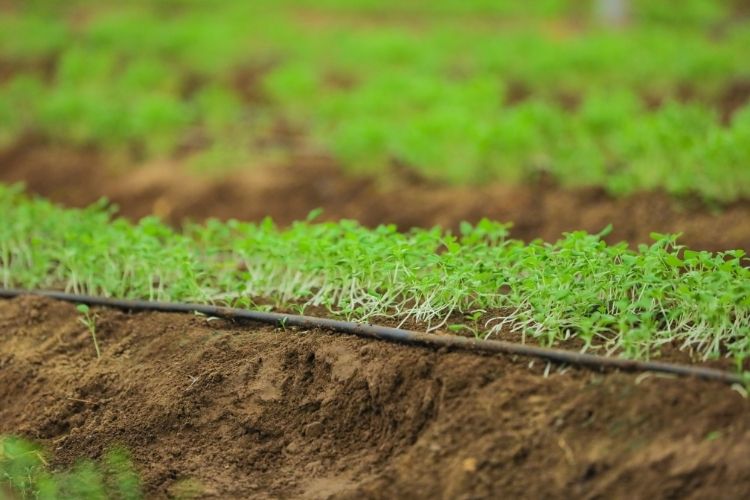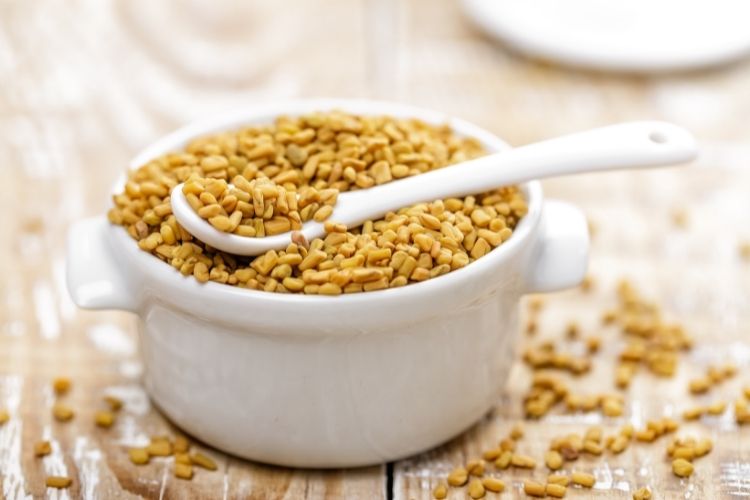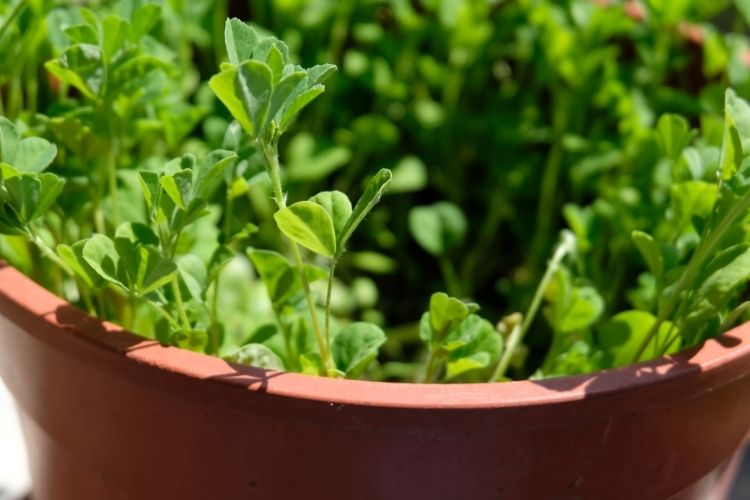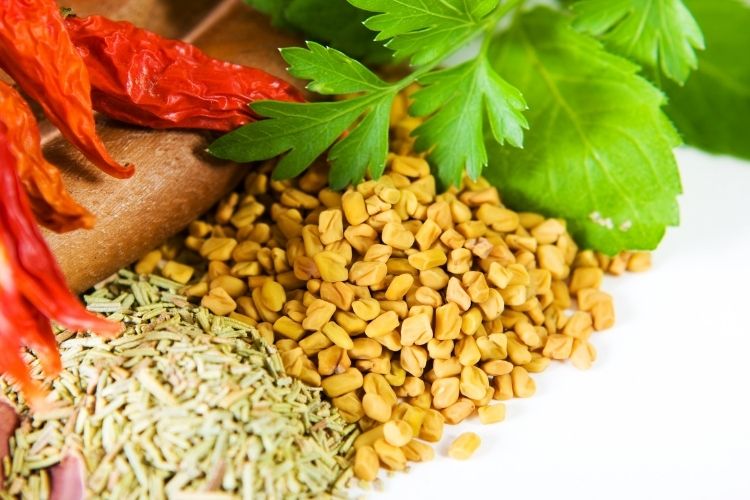- Fenugreek: How and Why Should You Grow It Yourself? - June 14, 2021
An ancient flavoring and fodder, fenugreek continues to populate global domestic gardens. The seeds of this plant have been recovered from Bronze Age levels of Israel, radiocarbon dated to 4000 BC in Iraq, and even found within the tomb of ancient Egyptian Pharaoh Tutankhamun (King Tut) from the 18th dynasty of Egypt.
This archaic plant is anything but old news though. If anything, this plant has been gaining popularity throughout the West due to its common culinary, ayurvedic, and medicinal purposes.
Why Should You Incorporate Fenugreek Into Your Established Garden Now?
This small seed is a powerhouse with its incredibly diverse applications! Whether you are looking to spice up your kitchen dishes, nourish your body back to health, or explore a more natural route to treat common ailments- fenugreek can offer you just that.
Culinary Use

In both herb and spice form, fenugreek is a common ingredient in middle eastern curries. It delivers a pungent and bitter, yet maple-sweet taste, often making or breaking the desired dish. Fenugreek is best used in combination with other complementary spices such as cumin and coriander as it is known to be quite overpowering on its own.
Unlike other spices, toasting these seeds alone will not eliminate their bitterness and may only add to their tough nature. When using fenugreek seeds in culinary dishes, it is recommended to soak and grind them before adding them to any recipe.
This seed can be tricky to find in moderately sized western grocery stores and quickly loses its unique flavor profile after being ground. Searching for fenugreek leaves can also often lead you on a drawn-out treasure hunt – even more reasons for growing your own plant at home!
Nutritional Content
- Thiamin
- Folic acid
- Riboflavin
- Niacin
- Vitamin A
- Vitamin B6
- Vitamin C
- Vitamin K
- Copper
- Potassium
- Calcium
- Iron
- Selenium
- Zinc
- Manganese
- Magnesium
Ayurvedic Energetics
Known here as methi dana, fenugreek is a warming seed benefiting both Kapha and Vata Prakriti
Medicinal Uses
- Hypoglycemic (Reduces blood glucose levels)
- Hypocholesterolemic (Reduces cholesterol levels)
- Hypotensive (Lowers blood pressure)
- Galactagogue (Stimulates milk production in nursing mothers)
- Carminative (Stimulates appetite and prepares the body for digestion)
How Do You Get Your Hands On Some Of These Prized Seeds?

Unless you are reading this from the East, landing yourself some quality fenugreek seeds can be a challenging task. If you still find yourself empty-handed after multiple grocery stores or garden center runs, don’t be discouraged.
This beautiful technology called ‘the internet’ makes all things possible- including getting fenugreek seeds into your possession promptly. My recommendations for sourcing high-quality fenugreek seeds online are:
- All seeds purchased from Strictly Medicinal Seeds are USDA certified organic, tested viable, GMO-free, untreated, open-pollinated, and public domain. Although Oregon-based, all orders are available for international shipping.
- Based in Ontario, Canada, Richters ships only within Canada and the United States.
- All seeds are GMO-free, open-pollinated, and untreated. Based in Queensland, Australia, All Rare Herbs ships seeds internationally.
If you prefer a more organic method of sourcing your seeds, check out your local seed swaps or reach out to your community gardens.
Where Do You Even Begin When Growing Your Own Fenugreek?
Step 1: Decide If You Will Sow Your Fenugreek Seeds Direct or in Trays/Modules

What does this even mean?
Direct sowing means to plant your seeds in the ground outside that you wish for them to grow indefinitely. Depending on your environment, this is often the easiest method as transferring seedlings from tray to earth may result in damaged seedlings.
This is especially true for fenugreek as it is part of the Fabaceae family which is known for its intolerance to disturbance once germinated. Sowing in trays or modules allows you to begin the process in any season and in a much more controlled environment.
To achieve the best of sowing both directly and in trays- try sowing your fenugreek seeds in biodegradable pots that can be transported directly into the earth at a later date without risking the health of your plant.
Fenugreek seeds may be sowed from early spring into late summer. However, they also require a full growing season of roughly 4-5 months. With this vital information in mind, determine which method will yield the best results for your new fenugreek plant in your current environment.
Step 2: Soak Your Fenugreek Seeds

Have you ever tried to grind your whole, dehydrated fenugreek seeds into a powder at home? If you’re anything like me, you have, and you’ve quickly discovered just how solid these seeds are before they are soaked. But how do you know if your seeds need to be soaked? The most simple answer to this is determining if the seed is wrinkled on the outside or not. When you see a wrinkled seed, you know that it has been dehydrated.
The main biological reason for this is to keep it safe from rot while it is stored, and therefore requires rehydration before planting.
The rehydration process of the seeds reactivates the metabolism process, releasing the radicle (embryonic root) from the hard seed casing. This allows the seed to sprout, find nutrients in the soil, and begin the beautiful germination process.
Now that you have determined if your fenugreek seeds need to be soaked (reminder, the correct answer here is ‘yes’), let’s explore the process.
To begin, find yourself an appropriately sized bowl to fit both your dehydrated seeds and adequate water to cover them completely. Remember to allow for submergence space when the seeds slightly expand upon rehydration. Place your seeds in the bowl and add enough warm tap water to submerge them completely.
Allow your seeds to soak overnight, however, do not allow your seeds to soak for more than 24 hours. Fun fact- these seeds need to breathe just as much as we do! Submerging the seeds for an extended amount of time will deprive your seeds of oxygen and ultimately suffocate them.
If you’re an extra diligent gardener, you may also decide to change the water throughout the process, replenishing their oxygen supply and further eliminating germination inhibitors.
As your seeds begin to rehydrate, you will notice the seed coating becoming more smooth and the seed itself plumper. Once you are finished soaking your seeds, remove them from the bowl and rinse them thoroughly. Looking alive and freshly showered, your seed babies are ready to hit the soil!
Step 3: Sow Your Fenugreek Seeds – Direct
To avoid delay in transferring your seeds to the soil, plan to complete this process when the weather and your schedule allow you to follow through on this commitment.
Fenugreek isn’t an overly high maintenance plant however it does have some specific requirements to thrive. You will want to plant your seed ½ inch deep and 2 inches apart in cool, well-drained soil. Aim to find a location with a soil acidity level between 5.8 to 8.2 PH, and that bathes in sunlight for the entire day.
OR:
Step 3: Sow Your Fenugreek Seeds – Trays or Modules
Unlike when sowing your seeds directly, the weather is a non-issue here. When sowing in trays or modules you will still want to make certain to plant your seeds ½ inch deep into cool, well-drained soil immediately after they have been rinsed.
Fenugreek is a fairly small plant, reaching a maximum height of 2 feet at maturity, so growing these along your window sills or in small containers is a realistic venture. One advantage to this growing method is the easy drainage of trays or modules. This plant’s craving for continuous sunlight, not just your usual 6-8 hours, could be seen as an advantage or disadvantage depending upon which directions your windows face within your home.
Step 4: Care For Your Growing Fenugreek Plants

Watering
Water well and keep soil well-moistened, but do not overwater as this will result in waterlogged soil, causing your plant to suffocate. If you reside in a community where water is scarce, you can reduce your water consumption when caring for your plants by:
- Making an effort to water your plants in early mornings or late evenings
- Grouping plants with similar watering requirements together
- Collecting and watering plants with rainfall
- Becoming aware of soil contouring (slope and shape of the land)
- Practicing deep mulching to keep the soil cool and slow evaporation
Fertilizing
As fenugreek belongs to the Fabaceae (legume) family, they require little fertilizer. If you prefer a natural approach to fertilizers, try adding simple home compost, which will slowly deliver nutrients into the soil.
Not sure which foods are recommended to compost? Think classic American breakfast- coffee, eggs, and bacon! Our favorite morning pick-me-up serves as a multipurpose weapon here. Once you’ve drained your french press of java, sprinkle a small quantity of the used coffee grounds into your soil to increase its acidity levels!
And what is breakfast without a couple of eggs? Instead of throwing your empty shells in the garbage- simply rinse, crush, and feed to your plants. This creates a more alkaline and calcium-rich environment for your soil. Last but not least, bacon.
If you’re an avid bacon fan you may have accumulated quite a bit of aftermath grease. Pour a small amount into your outdoor garden, attracting earthworms who will quickly convert this into fertilizer.
When adding coffee grounds or eggshells to your soil, do so conservatively. Remember, fenugreek prefers a fairly neutral PH soil level between 5.8 and 8.2.
Preventing pests and diseases
Slugs and snails love a good immature fenugreek salad for breakfast. To keep these guys at bay during the growing process, try some of these easy and natural solutions.
- Reducing your garden humidity
- Preventing overground travel (Surround your plant with ash, eggshells, coffee grounds, fermented liquids, or copper wire)
- Keeping pets indoors, encouraging bird feeding
Pests are rarely a major problem for mature fenugreek plants. The reasoning behind this is the fact that mature fenugreek contains pesticidal properties within itself. Extracts of the leaves and seeds are often used in commercial pesticides to deter slugs, snails, and beetles.
If all else fails- look into creating or purchasing some biopesticides which are made from naturally occurring materials such as plant extracts of neem or citronella. Root rot is a potential concern with fenugreek, however, it is easily prevented by proper watering and ensuring soil drainage.
Companion plants for fenugreek
Companion planting is a gardening and agricultural strategy to maximize the growth of multiple different plants by planting them near each other. Among the many outcomes of companion planting are pest deterrence, soil fertility, and nutrient maximization.
The best companion plants for fenugreek are:
- Buckwheat (Fagopyrum esculentum)
- Beans (Phaseolus vulgaris)
- Crowder peas (Vigna unguiculata)
Harvesting Your Fenugreek

The time to reap what you’ve sowed has come! Fenugreek’s clover-shaped foliage may be picked and enjoyed any time after 4 weeks, but do bear in mind that the younger leaves do have a stronger bitter quality than the matured leaves.
To harvest fenugreek seeds, a little more patience must be practiced. Once the pods have fully ripped (between 3-5 months of maturity) they will become fully yellowed. This is the prime time to harvest your seeds. Avoid delaying harvesting your seeds, as once they fully ripe they will begin to break open, reducing your harvest significantly.
Harvesting your seeds entails uprooting the entire plant and hanging or placing it on drying racks to allow for the natural dehydration process to begin. Be cautious not to hang your fenugreek plants in clusters to dry, and this can often result in a moldy final product. Once completely dehydrated- your seeds and leaves may be collected.
Store your dehydrated whole seeds or whole leaves in airtight, UV-resistant (amber) glass jars. Do not grind seeds or leaves for storage as this induces oxidization, reducing both taste and medicinal efficacy.
Remember to always label your harvest with the correct name and date of harvest. At the moment you may be certain you will remember what and when you harvested, but I warn you from personal experience, chances are you will forget. When stored properly, your dried harvest materials may last up to one year.
FAQs
Answer: Yes! Fenugreek can be grown indoors or outdoors, it is fairly pest-resistant, and requires little fertilizing.
Answer: Fenugreek foliage may be harvested as soon as 3-4 weeks, and fenugreek seeds anywhere between 3-5 months or as soon as the plant pods have yellowed.
Answer: No. Fenugreek is an annual plant- meaning that it does not regrow every spring, unlike perennial plants.
Answer: Yes. Soaking your fenugreek seeds before planting them reactivates the metabolism process, releasing the radicle (embryonic root) from the hard seed casing. This allows the seed to sprout, find nutrients in the soil, and begin the beautiful germination process.
Summary
Growing these precious seeds of vast culinary and medicinal value doesn’t have to be a challenge. Fenugreek is a moderately carefree plant that thrives in full sun and moist, well-drained soil.
Although not as easily sourced in the West as some culinary herbs or spices, it is readily available online and potentially even within your local community, all you have to do is a little digging to source, grow, and harvest these gems. Happy sowing!

